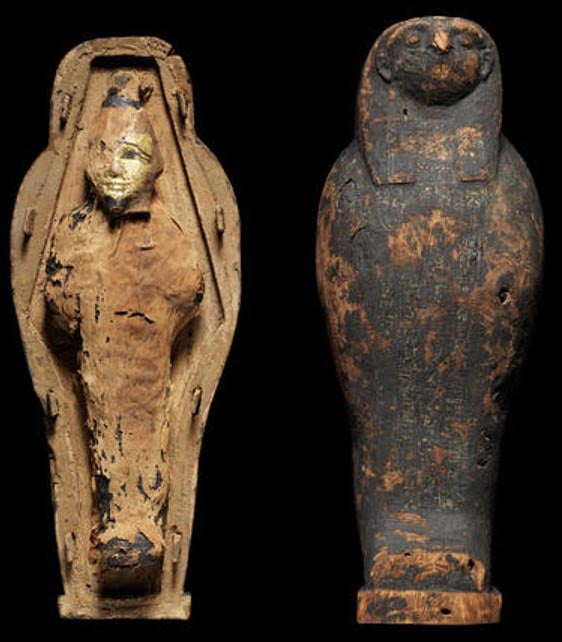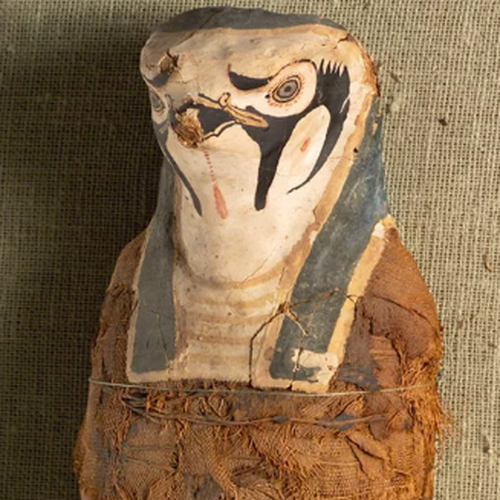
Two ancient Egyptian sarcophagi were believed to contain human remains. One of them was thought to be a mummified child as it has the appearance of a “small human”. However, CT scanning in 2020 revealed a surprise inside! The mummies were not, in fact, human. One of them was a bird representing the god Horus and the other “child-like” mummy, was packed with mud and grains in the shape of the god Osiris.

For many decades, both of these ancient sarcophagi had been part of the National Maritime Museum’s collection and while their origins are unknown, the museum’s official records suggested that they contained mummified hearts. But when a team of archaeologists CT scanned the 3,000-year-old “bird and child-like” mummies at Rambam Hospital in Haifa, Israel, the remains of the child-like mummy were found to be a votive offering to Osiris, the Egyptian god of death and lord of the underworld, in the form of a mud and grain packed dummy.

The two mummies date back between 2,500 and 3,000 years and according to a Daily Mail report, the director of medical imaging at Rambam, Dr Marcia Javitt, said the smaller mummy was “bird-like” and contained a mummified bird, most likely a falcon, which was symbolic of Horus, the ancient Egyptian god of kingship and the sky. The larger of the two mummies resembled “a small child” and it turns out that it was actually a hand-crafted plant matter doll representing the god Osiris, and this artifact according to Ron Hillel from Haifa Museums is known as a “grain mummy” or “corn mummy”.

In ancient Egypt when a mummy was being placed in its tomb, artifacts and mummified animals were also added to symbolically protect the mummified remains and the journey of its soul to the afterlife, and the researchers said it is possible these two mummies were buried in a “Pharaoh’s tomb,” as an offering to the gods on behalf of the deceased.

An example of a ‘grain mummy’ (600 – 400 BC) in the form of the god Horus (CC by SA 4.0 / Wolfgang Sauber)
Guardians of A Deceased Pharaoh?

Dr Javitt said the ancient Egyptians mummified numerous animals including: cats, crocodiles, fish as votive offerings and food for the afterlife, but birds had a very important post-death role in ancient Egypt because they were thought specifically as “protectors,” so they would often place mummified birds and bird-shaped artifacts inside the Pharaoh’s tombs. And while Dr Javitt makes it clear she is not saying this mummified bird definitely came from the tomb of a Pharaoh, she said “it’s conceivable that it had something to do with that kind of story”.
The team of researchers combined conventional CT scanning with cutting-edge dual energy CT scanning, also known as “Spectral CT,” which is a computed tomography revealing density, and Dr Javitt said “With mummies, the bones get less dense, the tissues get dehydrated, and it’s nothing like scanning a live animal, human or other creature, because the tissue relationships are much different. However, the dual energy CT allowed the researchers to measure the atomic number of the tissue which is not dependent on hydration or condition – “it’s elemental” said Dr Javitt.

An example of a ‘corn mummy’ in the form of the god Osiris. While the mummy looks like a small child, it is actually made with mud and grains (CC by SA 3.0 / Bombaladan)
Questioning the Protected Soul’s Origins
The research revealed much about how these two ancient mummies were made, and it is known that they symbolically assisted a deceased Egyptian’s soul after death. Because ancient Egyptians believed in the soul’s immortality, the moment of death was considered a temporary interruption in a journey, rather than what it is today – the cessation of life. And to ensure the continuity of life after death the people paid homage to the gods both during and after their life on earth.
However, what these two mummies represented is only a part of the story and Dr Javitt and her counterparts at the museum told press that they were planning to get back to work with the specific goals of determining the origins of the pair of mummies. And to solve the mystery of exactly whose soul the child and bird mummies were designed to protect, the doctor said she and her team would work like “anatomic and archaeological detectives” until they answer all of remaining questions.
